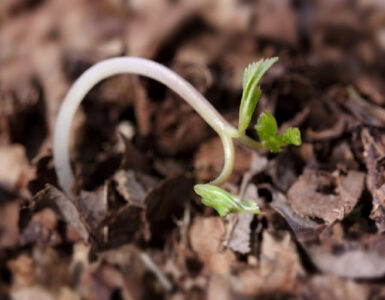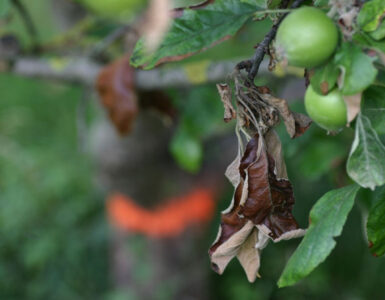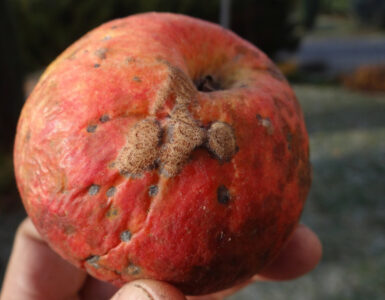Verticillium wilt is a significant disease affecting a wide range of plants. It causes wilting, yellowing, and ultimately the death of plants by invading the vascular system.
Controlling this disease can be challenging. However, there are several natural methods that can help manage and reduce its impact.
This article will explore some of these methods under various subheadings.
Identification
Verticillium wilt is a soil-borne fungal disease. It affects many plants.
The fungus invades the plant’s vascular system, blocking water and nutrient flow. Plants wilt and eventually die.
Recognizing the symptoms is crucial for early intervention.
Common signs include yellowing of leaves and wilting. The death of leaves and branches are also symptoms [1]. Besides, there may also be dark streaks in the vascular tissues when the stem is cut.
As mentioned, this disease affects many plants. This includes vegetables, fruits, ornamental plants, and trees. It can result in significant crop yield loss as well as a decline in ornamental plants and trees.
Maple trees are often affected. Lilac, ash, elm, and smoke trees are also vulnerable.
Many food crops can also suffer from it. Tomatoes, peppers, and eggplants are common targets. Strawberries, elderberry, and potatoes may also be affected.
How to Get Rid of Verticillium Wilt Naturally
Controlling verticillium wilt naturally requires an integrated approach, focusing on prevention, soil health, and biological controls.
Regularly monitor your plants for early signs of the disease. Early detection allows for prompt action. This includes removing infected plants, preventing further spread.
Moreover, keeping a close watch on plant health can help you respond quickly to any issues that arise. Below are some natural strategies to help manage this disease.
1. Proper Pruning
Prune infected branches immediately and dispose of the material properly. This will help prevent the spread of the fungus.
Regular pruning also promotes overall plant health.
2. Proper Watering
Proper irrigation practices can help prevent verticillium wilt. Ensure proper drainage and avoid excessive irrigation to reduce stress on plants.
Overwatering or poor drainage can also worsen the disease by creating favorable conditions for fungal growth.
Also, avoid overhead watering. Use drip irrigation or soaker hoses to deliver water directly to the root zone. This will help reduce the spread of fungal spores.
3. Proper Fertilizing
Avoid fertilizers with high nitrogen levels. However, a high-phosphorus fertilizer is okay.
Compost also improves soil health, so incorporate organic matter into the soil.
Healthy soil with a good microbial community can outcompete and suppress soil-borne pathogens, including verticillium wilt fungi.
4. Control Weeds
Weeds can host the fungus, so keep garden areas weed-free. Mulch helps suppress weeds.
You can also use landscape fabric if necessary. Or, hand-pull weeds regularly.
5. Remove Badly Infected Plant Entirely and Destroy
If a plant is badly infected, remove it. Dig up the entire plant, including roots, and destroy all plant materials.
Do not compost them. This prevents the fungus from spreading. That’s because the fungus can survive the composting process.
6. Crop Rotation
Do not plant susceptible plants in the same spot for at least four years. The fungus can remain in the soil. Therefore, replanting with host plants can prolong the disease.
Instead, choose plants that are resistant. This helps break the disease cycle.
Rotating host crops with non-host plants can reduce the fungal population in the soil. Non-host crops such as cereals, corn, or grasses are helpful in this case [2].
7. Mulching
Mulch with organic materials like straw, leaves, or wood chips. This improves soil health. It also retains moisture and regulates temperature.
Mulch can also create a barrier that reduces soil splash, which can spread fungal spores to healthy plants. Additionally, mulch can suppress weed growth, which can otherwise compete with your crops and harbor pests and diseases.
8. Grafting Techniques
For perennial crops and trees, you can also use resistant rootstocks and graft susceptible varieties onto them. This may help provide protection against this plant disease.
9. Proper Sanitation
Clean pruning tools regularly. Disinfect them after each use. This prevents the spread of the fungus. Proper tool hygiene is crucial.
Proper garden sanitation is also crucial in managing this plant problem. Remove and destroy infected plant material promptly to prevent the spread of the disease.
10. Beneficial Microorganisms
Introducing beneficial microorganisms into the soil can help suppress this disease.
For example, Bacillus subtilis NCD-2 may inhibit the growth of cotton verticillium wilt [3]. Trichoderma asperellum is also effective in the suppression of Verticillium wilt of olive [4].
These biological control agents compete with or parasitize the harmful fungi, thus reducing their population.
11. Compost Teas
Applying compost teas rich in beneficial microbes can improve soil health.
Compost tea can also be a great home remedy for this disease. It has a positive effect in treating Verticillium wilt in strawberries [5].
12. Soil Solarization
Use soil solarization to kill the fungus. This is a non-chemical method for controlling soil-borne pathogens. This technique involves covering the soil with clear plastic sheeting.
Do this during hot, sunny months. Leave the plastic in place for 4-6 weeks. The heat will kill many soil pathogens, including the fungus that causes this plant disease.
13. Actinovate® AG
You can also use Actinovate® AG for control. It is an organic fungicide that is effective in controlling many soil-borne diseases.
It works great against Verticillium, damping-off, Armillaria root rot, and more. Follow the application instructions carefully.
Takeaway
Controlling verticillium wilt disease naturally requires a varied approach. This has to do with prevention, soil health, and biological controls.
By mixing these strategies, gardeners and farmers can reduce the incidence and impact of this disease.
Healthy soil and plants are the best defense against this disease. So, focus on building a resilient and balanced ecosystem in your garden or farm.
Picture via extension.umd.edu








Add comment